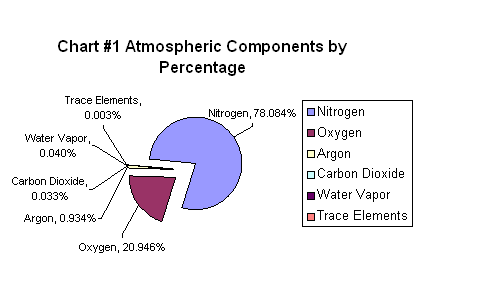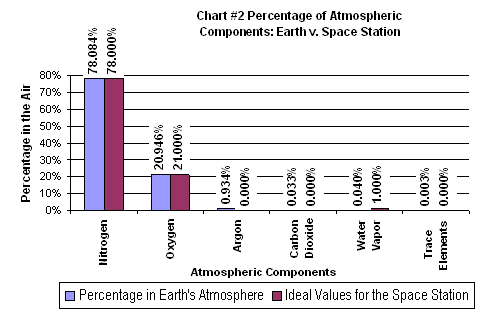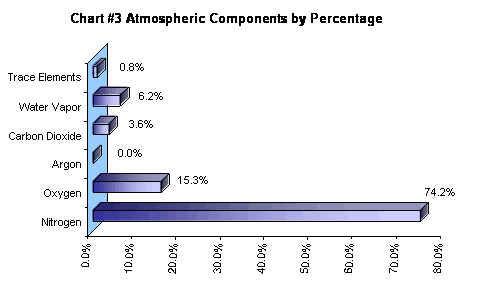

The air we breathe on Earth is composed of a mix
of different gases. Scientists have conducted experiments that tell us
how much of each type of gas is normally found in pure air. With this
information we can create Table #1 and Chart #1: Atmospheric Components
by Percentage
| Table 1 | |||
| A | B | C | D |
| Atmospheric Component | Percentage in Earth's Atmosphere* | Ideal Values for the Space Station | Astronaut Exhalation |
| Nitrogen | 78.084% | 78.000% | 74.200% |
| Oxygen | 20.946% | 21.000% | 15.300% |
| Argon | 0.934% | 0.000% | 0.000% |
| Carbon Dioxide | 0.033% | 0.000% | 3.600% |
| Water Vapor | 0.040% | 1.000% | 6.200% |
| Trace Elements | 0.003% | 0.000% | 0.800% |
| *Composition of the atmosphere at sea level, in clean air, no weather disturbance, at Standard Temperature and Pressure. | |||
Chart #1 Represents the Most Natural
Mix of Air
Chart #1 gives us a "snapshot" of the usual mix of atmospheric
gases, minus any pollutants. If we go outdoors and fill a box with air,
can we isolate the exact mix of gas molecules that is in the pie chart?
Perhaps-- but only in the most isolated areas such as deep in the woods
or high on a mountaintop. We might be able to produce this exact mix of
gases in an enclosed space such as the space station, but the mix would
change as soon as the astronauts entered and began breathing.

On Earth, the air's mix of gases changes with
gaseous emissions from natural sources such as volcanoes and man-made
sources such as gasoline-powered vehicles and chemical processing industries.
Recent studies show that man's activities can significantly alter the
mix of gases in the air.
Gases in the Earth's
Atmosphere
Take a moment to look at and think about Table #1, Columns A & B,
and Chart #1. Then answer the following questions:
1. Chart #1
tells us that our air is a mix of different gases. According to the table
and pie graph, what are the three major gases of the atmosphere?
2. Why do you think some of the
gases listed in the table are not able to be seen on the chart?
3. Which ones are not recorded?
4. Which gas is the most critical
for sustaining human life?
Ideal Values for Atmospheric
Gases on Space Station Alpha
How does the gaseous mix of atmospheric components
on Earth compare to the mix on board the space station? Examine Table
1, Columns B & C, and Chart #2 below for the answer.

5.
Why do you think that the ideal Space Station Alpha gases consist mainly
of nitrogen, oxygen, and water vapor? Explain why each type of gas is
necessary.
6. If the atmosphere in the space station started with this ideal mix before humans arrived, why do we have to worry about the space station's atmosphere?
Take a deep breath
- Now, don't let it out!
On Earth, we breathe in the air in Chart #1. On
Earth and in the space station, the astronauts (and you) breathe out the
air in Chart #3.

Study Chart #3. Compare it to the values shown in Chart #2- the Earth's
atmosphere and the space station atmosphere.
Something happens in the human body to the air that is breathed in. By studying and comparing all four Tables and Charts, we begin to understand, not only that the body uses the oxygen it breathes, but also that the body's natural processes produce a new mix of gases. On Earth, this is not an issue. There is a lot of air, more than enough for dangerous gases to disperse harmlessly. But on the space station, human emissions are an important issue.
The Dangers from Breathing
on the Space Station
As we can see from Chart #3, the astronauts are actually polluting the
air in their own Space Station; and the harder they work and exercise;
the more they pollute their own atmosphere. They behave, in fact, like
earth-bound factories without environmental control systems. Consider
the gases coming out of the astronauts. It is important that excess amounts
of carbon dioxide and the trace elements and water vapor, all of which
are being produced by the astronaut's bodies, are removed from the air.
If they are permitted to accumulate within the space station, they will
pollute the atmosphere, crowd out the critical gases and cause a serious
threat to the well being of the astronauts.
Excessive accumulation of carbon dioxide in the atmosphere may cause the astronauts to suffer from carbon dioxide poisoning. The astronauts also produce methane, ammonia, urea, and other poisons that are very natural gases for the body to produce, but they pollute the air in the Space Station. Consider the percentages of nitrogen and oxygen in Chart 3. The astronauts are using up the oxygen. If the atmosphere is not enriched with oxygen, the astronauts are in danger of hypoxia. Both hypoxia and carbon dioxide poisoning are serious conditions that threaten the astronauts both physically and mentally. Both conditions occur without a person becoming aware. In both conditions humans become disoriented-- unable to make clear, correct decisions.
Maintaining a correct amount of water vapor is also very important. Too much water vapor creates the danger of condensation. Too little water vapor increases the possible accumulation of static electricity and the danger of sparks.
On the space station, sensors attached to computers are constantly at work taking readings and sending signals to the equipment designed to make adjustments to the air's composition. Nitrogen and oxygen stored in tanks is released into the atmosphere upon command. Sensors are the eyes and ears of the space station's Environmental Controls and Life Support Systems Diagram. Maintaining a healthy atmosphere and a healthy atmospheric pressure on the Space Station is a constant challenge. There are multiple back-up and safety devices on board as well. If the mix of gases, the pressures of the different gases, and the total air pressure on board the space station are not monitored and maintained, the astronauts could be in danger without even knowing it.
